When you start to explore vintage motorcycle engine specifications, you quickly realize how essential they are for understanding the performance of classic bikes, particularly models like Ducatis. You might find it intriguing how metrics such as displacement and compression ratio shape not just the bike's power output, but also the overall riding experience. But what happens when you consider unique features, like desmodromic valves? The nuances in these specifications could change your perspective on vintage motorcycles entirely, and you'll soon see why enthusiasts are so passionate about these machines.
Key Takeaways
- Vintage motorcycle engine specifications include key metrics like displacement, compression ratio, and power output, which affect performance and riding experience.
- Understanding desmodromic valve systems and L-twin configurations helps in appreciating Ducati's unique engineering and performance characteristics.
- Regular maintenance, including oil changes and spark plug inspections, is crucial for the longevity and performance of vintage motorcycle engines.
- Upgrading carburetors and exhaust systems can significantly enhance engine responsiveness and overall performance for vintage motorcycles.
Overview of Ducati Motorcycles
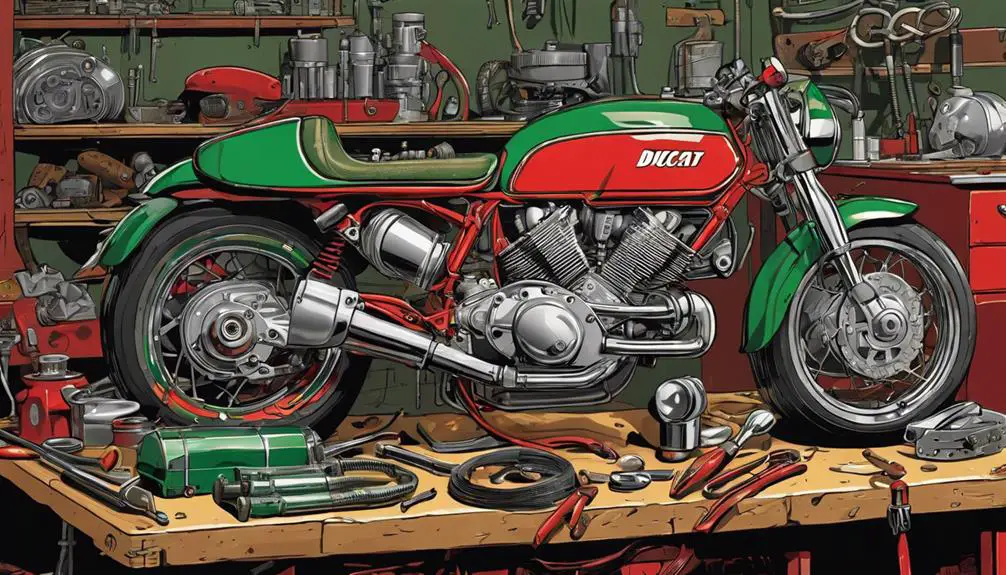
Ducati motorcycles, known for their distinctive design and performance, have carved out a unique niche in the world of vintage bikes. When you ride a Ducati, you're not just hopping on any motorcycle; you're embracing a legacy of engineering excellence and rebellious spirit. The bold styling and attention to detail can make you feel alive, as if the bike is an extension of your own desires for freedom and adventure.
From the iconic L-twin engines to the lightweight frames, each model exudes an air of sophistication and raw power. Whether you're zipping through city streets or cruising along winding country roads, Ducati offers a thrilling experience that resonates with those who seek liberation from the ordinary. You'll appreciate the blend of tradition and innovation, as these motorcycles have evolved while still honoring their roots.
Riding a vintage Ducati isn't just about the mechanics; it's an expression of individuality. You're part of a community that values passion, history, and the joy of the open road.
Evolution of Ducati Engines
Over the years, Ducati engines have undergone remarkable transformations, showcasing advancements in technology and performance that cater to the demands of modern riders. You'll notice how the shift from air-cooled engines to the more efficient liquid-cooled designs has dramatically improved reliability and power delivery.
As you investigate these engines, you'll appreciate the introduction of desmodromic valve systems, which revolutionized performance by allowing for precise timing and better revs.
Ducati's embrace of fuel injection marked another significant leap, optimizing fuel delivery and enhancing throttle response. This evolution isn't just about raw power; it's about control and the exhilarating freedom you feel when riding.
The introduction of advanced electronics, like traction control and ride modes, has further refined your experience, allowing you to tailor your ride to suit your style and environment.
As you explore deeper into Ducati's journey, you'll recognize how each innovation reflects a commitment to pushing boundaries while honoring the brand's rich heritage.
With every twist of the throttle, you're not just riding a bike; you're becoming part of a legacy that champions liberation on two wheels.
Key Engine Specifications
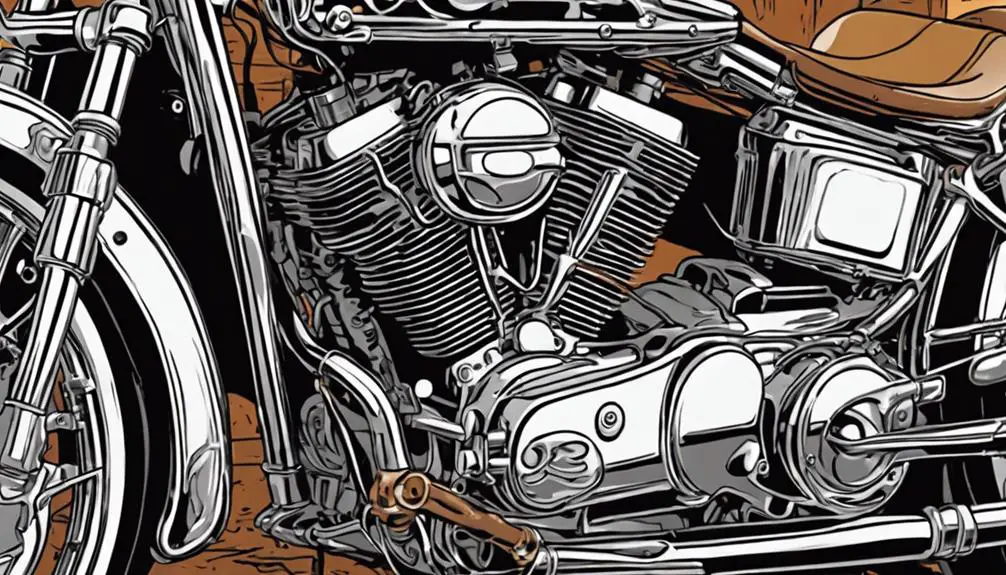
When examining vintage motorcycle engines, you'll find key specifications like displacement, compression ratio, and valve configuration that define their performance and character.
These elements not only influence how the bike rides but also reflect the freedom and spirit of the era they come from. Understanding these specs can enhance your appreciation and riding experience.
- Displacement: This refers to the total volume of the engine's cylinders. Larger displacement typically means more power, giving you that exhilarating rush as you hit the open road.
- Compression Ratio: A higher compression ratio usually translates to better efficiency and power output. It's the sweet spot where performance meets the thrill of liberation.
- Valve Configuration: The arrangement and number of valves impact airflow and engine responsiveness. Whether it's a single overhead cam or a more complex setup, this plays a vital role in how the bike performs.
Common Ducati Engine Types
When you think about Ducati engines, the Desmodromic valve system stands out as a unique feature that sets them apart.
You'll also notice the L-Twin configuration, which contributes to their distinctive performance and sound.
Let's explore these common engine types and their performance variants in more detail.
Desmodromic Valve System
The desmodromic valve system is a distinctive feature of many Ducati engines, ensuring precise valve control for enhanced performance. This unique design utilizes two separate cam lobes for each valve—one to open and another to close—allowing for faster and more accurate valve operation. You'll feel the difference as you ride, with exhilarating power and responsiveness that liberates your spirit on the road.
Imagine the thrill of a desmodromic engine delivering:
- Unmatched Precision: Every valve movement is meticulously controlled, reducing the risk of float at high RPMs.
- Enhanced RPM Range: With this system, you can push your engine to its limits, feeling the surge of power as you accelerate.
- Reduced Valve Wear: The design minimizes stress on the components, giving you confidence in your bike's reliability.
When you ride a Ducati equipped with a desmodromic valve system, you're not just riding a motorcycle; you're embracing freedom, experiencing the art of engineering that speaks to the heart of every enthusiast.
You'll understand why this system is revered in the vintage motorcycle community as a hallmark of performance and innovation.
L-Twin Configuration
Ducati's L-Twin configuration stands out as a defining characteristic of their engines, delivering a unique blend of power and agility that enhances your riding experience. This layout features two cylinders arranged in a V-shape, offering superior torque and a distinctive sound that resonates with freedom. When you twist the throttle, you'll immediately feel the L-Twin's responsiveness, making every ride exhilarating.
The design not only contributes to a lower center of gravity but also keeps the bike nimble and easy to handle. You'll appreciate how this configuration allows for rapid cornering and a more connected feel to the road. Plus, the character of the engine provides an unmistakable Ducati vibe, inviting you to push boundaries and embrace the open road.
With various displacements and tuning options, the L-Twin caters to different riding styles, from spirited canyon carving to long-distance touring. It's about the thrill of the ride, where every twist and turn feels like an extension of your will.
In the world of vintage motorcycles, Ducati's L-Twin stands as a demonstration of the power of engineering that lets you experience liberation in every ride.
Performance Variants Overview
Exploring the various performance variants of Ducati engines reveals a range of unique characteristics that cater to different riding preferences and styles. Whether you're tearing up the track or cruising the open road, Ducati offers something for everyone.
Here are three common engine types that embody this spirit of freedom:
- Desmodromic L-Twin: This iconic engine delivers a distinctive throaty growl, providing you with raw power and unmatched torque. Perfect for those who crave adrenaline on every ride.
- V4 Panigale: With a finely-tuned rev range, this engine combines high performance with agile handling. It's a beast that takes you to exhilarating speeds, satisfying your need for liberation.
- Scrambler Engine: Designed for versatility, this engine allows you to navigate both urban jungles and rugged terrains. Experience the thrill of exploration with a bike that adapts to your adventurous spirit.
Each engine variant not only defines performance but also enhances your connection with the road. Embrace the freedom that comes with the right Ducati engine, and ride with purpose.
Performance Metrics Explained
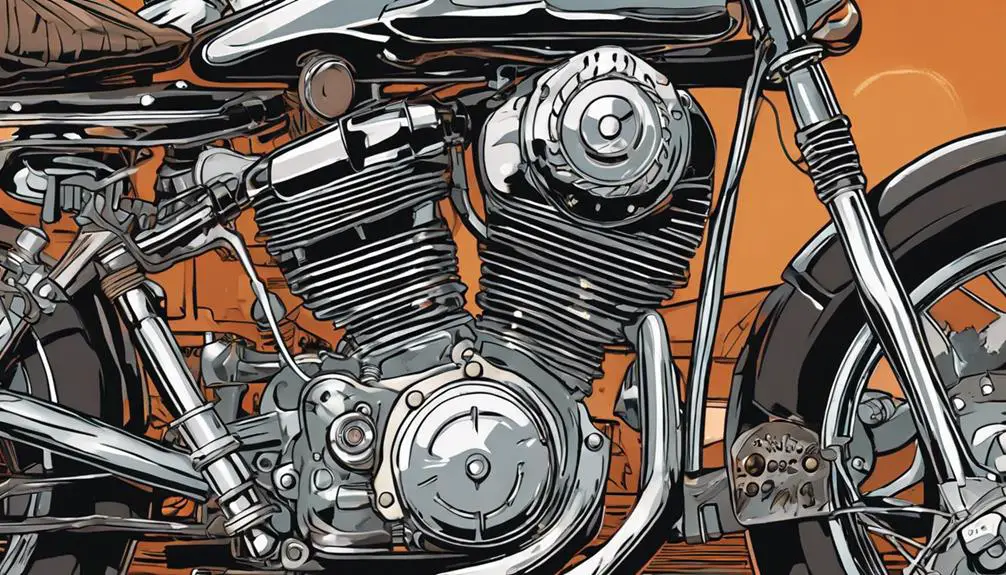
Understanding how vintage motorcycle engines perform requires a closer look at key metrics like horsepower, torque, and RPM. These figures are your roadmap to releasing the true potential of your ride.
Horsepower, often the star of the show, measures how quickly your engine can do work. The higher the horsepower, the faster your bike can accelerate, giving you that thrilling sensation of freedom.
Torque, on the other hand, is all about the twist. It tells you how much pulling power your engine has at different RPMs. When you twist the throttle, torque is what pushes you forward, making it vital for those exhilarating climbs and swift overtakes.
Lastly, RPM (revolutions per minute) reflects how hard your engine is working. Higher RPMs often equate to higher speeds, but knowing the sweet spot for your specific engine is essential. Too low, and you might stall; too high, and you could risk damaging your beloved machine.
Maintenance of Vintage Engines
Maintaining your vintage motorcycle engine is essential for its longevity and performance.
You'll want to focus on regular oil changes, spark plug inspections, and caring for the cooling system.
These simple steps can make a big difference in keeping your ride running smoothly.
Regular Oil Changes
Regularly changing the oil in your vintage motorcycle is crucial for keeping its engine running smoothly and efficiently. Fresh oil helps lubricate the moving parts, reduces friction, and carries away harmful debris. Neglecting this simple task can lead to costly repairs and a less enjoyable ride.
To make the most of your oil changes, consider these three key benefits:
- Enhanced Performance: Fresh oil guarantees your engine operates at peak performance, allowing you to feel the freedom of the open road without any hiccups.
- Increased Longevity: Regular oil changes help extend your engine's life, letting you savor every mile without worrying about unexpected breakdowns.
- Cost-Efficiency: By preventing engine wear, you'll save money in the long run, giving you more freedom to invest in upgrades and adventures.
Set a schedule for oil changes based on your bike's specific needs and riding habits.
Spark Plug Inspection
To keep your vintage motorcycle running at its best, a spark plug inspection should be part of your routine maintenance. These small but mighty components play an essential role in igniting the fuel-air mixture, ensuring your engine runs smoothly.
Start by removing the spark plugs with a socket wrench. Check for any signs of wear, such as cracks or excessive carbon buildup. A clean spark plug means a healthier engine, so don't hesitate to replace any that look worn out.
Next, examine the gap between the electrodes. If it's too wide or too narrow, it can lead to misfires and poor performance. Use a feeler gauge to measure the gap and adjust it according to your motorcycle's specifications.
Also, don't forget to inspect the spark plug wire connections. A loose or damaged wire can cause ignition problems, making your ride less reliable.
Cooling System Care
A well-functioning cooling system is essential for preventing overheating and guaranteeing your vintage motorcycle engine operates efficiently. When you ride, heat builds up in the engine, and without proper care, that heat can lead to serious damage.
To keep your engine cool and free, follow these essential maintenance steps:
- Check coolant levels: Regularly inspect your coolant to guarantee it's at the right level. Low coolant can lead to overheating and engine failure.
- Inspect hoses and connections: Look for cracks, leaks, or wear in your hoses. A small crack can lead to a significant coolant loss, so replace any damaged parts immediately.
- Flush the system: Over time, dirt and debris can accumulate in the cooling system. Flushing it every couple of years can help remove this buildup and keep your engine running smoothly.
Troubleshooting Common Issues
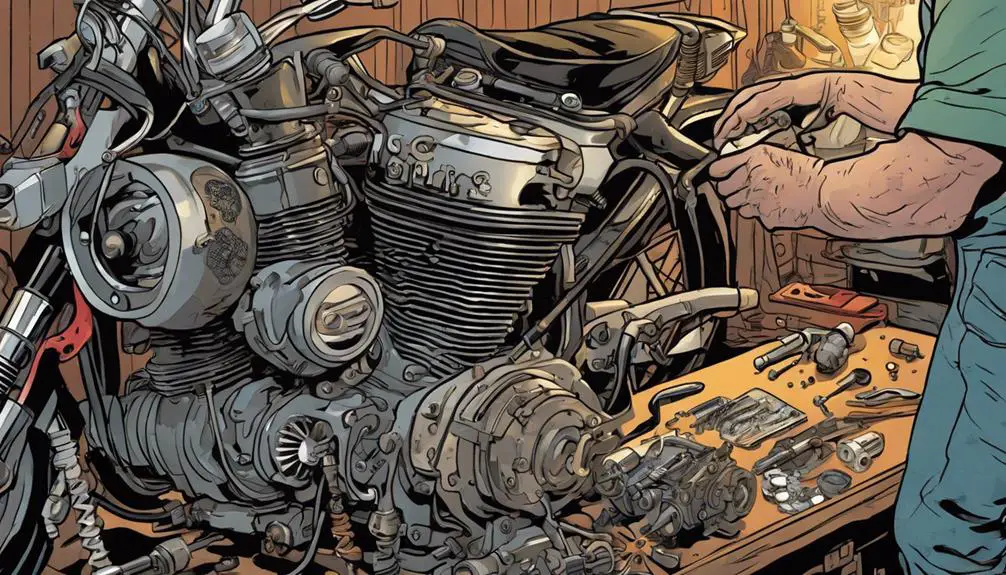
When vintage motorcycle engines exhibit problems, identifying the root cause quickly can save you time and money. Start by listening to your bike; strange sounds often signal trouble. If you hear knocking or rattling, check the oil level and quality. Low or dirty oil can lead to serious engine damage.
Next, if your engine struggles to start or runs rough, inspect the fuel system. Old fuel can gum up carbs or injectors, so consider draining and replacing it. Check for clogged filters too. You want your ride to breathe freely!
Another common issue is overheating. Verify your cooling system is functioning properly. Look for leaks and check the coolant level regularly. You wouldn't want your metal steed to boil over on the open road.
Lastly, inspect the electrical system. Faulty wiring, corroded connections, or a dying battery can stall your plans for freedom. A multimeter can help you trace issues and verify everything's in top shape.
Engine Upgrades and Modifications
When you think about boosting your vintage motorcycle's performance, engine upgrades and modifications become essential.
You'll find a variety of options that can enhance speed, efficiency, and overall riding experience.
Let's explore some common upgrades that can make a significant difference.
Performance Enhancements Overview
Performance enhancements for vintage motorcycle engines can dramatically improve your ride's power and efficiency, making upgrades and modifications essential for enthusiasts looking to boost their machine's capabilities. By releasing your bike's full potential, you can experience the freedom of the open road like never before.
Consider these three key performance enhancements that can transform your ride:
- High-Performance Carburetors: Upgrading to a more efficient carburetor can optimize fuel-air mixture, resulting in a snappier throttle response and increased horsepower.
- Aftermarket Exhaust Systems: Swapping out the stock exhaust for a performance-oriented system can improve airflow, reduce backpressure, and give your bike that stunning growl that turns heads.
- Ignition System Upgrades: Installing a modern ignition system can enhance spark efficiency, leading to smoother starts, better fuel economy, and a more powerful output.
These enhancements not only elevate your motorcycle's performance but also deepen the connection you have with your ride.
Embrace the journey of transformation, and let each modification take you closer to the exhilarating freedom that only a vintage motorcycle can offer.
Common Upgrade Options
Exploring common upgrade options for your vintage motorcycle engine can reveal a new level of performance and reliability. One of the most liberating upgrades you can make is to enhance the carburetor. Switching to a more efficient model can improve fuel delivery and throttle response, giving you a snappier ride.
You might also consider upgrading your exhaust system. A freer-flowing exhaust not only boosts horsepower but can also give your bike that raw, throaty growl you crave.
Don't overlook ignition systems, either. A modern electronic ignition can transform your bike's starting reliability and overall performance. It'll eliminate those frustrating kickstart moments and keep you cruising smoothly.
If you're feeling adventurous, you could even look into aftermarket pistons and cams. These components can greatly increase your engine's output, turning your classic ride into a powerful beast.
Lastly, tuning your engine with a professional can refine all these upgrades, ensuring everything works harmoniously. Embrace the journey of upgrading your vintage motorcycle, and release a thrilling experience that truly sets you free on the open road.
Historical Models and Their Specs
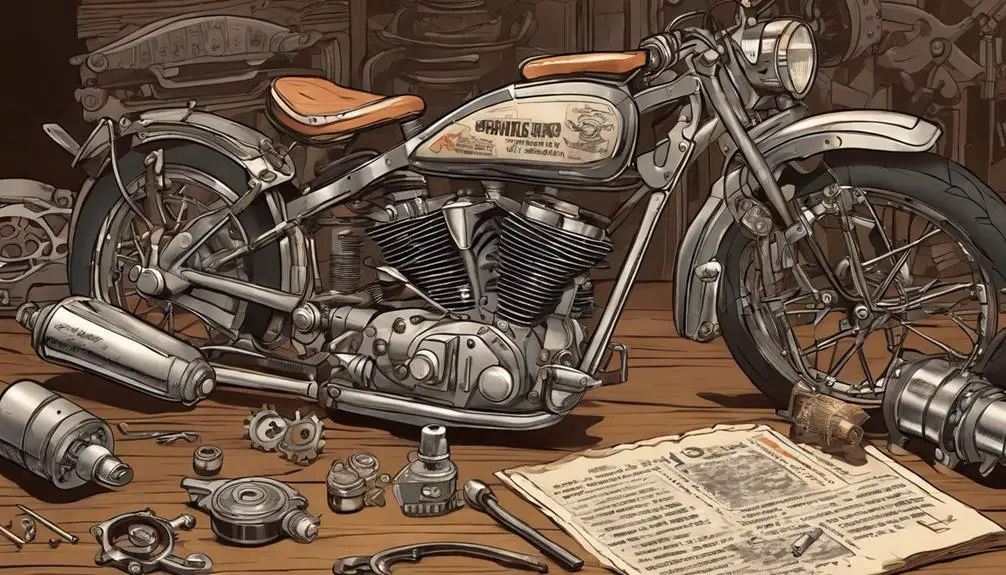
Many iconic vintage motorcycle models, like the 1949 Vincent Black Shadow and the 1967 Honda CB750, showcase unique engineering and specifications that highlight the evolution of motorcycle technology. These machines not only symbolize freedom on two wheels but also reflect the innovative spirit of their times.
Consider the following specs:
- Vincent Black Shadow (1949): With a 998cc V-twin engine, this beast churns out 55 horsepower. Its lightweight frame and aerodynamic design allow it to reach speeds exceeding 125 mph, making it one of the fastest bikes of its era.
- Honda CB750 (1967): Often dubbed the first superbike, it features a 736cc inline-four engine, delivering 67 horsepower. Its electric start and disc brakes were revolutionary, setting new standards for safety and convenience.
- Triumph Bonneville (1959): Powered by a 649cc twin engine, this classic produces around 40 horsepower. The Bonneville's timeless design and distinctive sound resonate with riders seeking a sense of adventure.
These historical models aren't just machines; they embody the spirit of liberation, inviting you to ride into the sunset and embrace the open road.
Resources for Ducati Enthusiasts
For Ducati enthusiasts, a wealth of resources awaits to help you connect with the rich heritage and engineering excellence that define this iconic brand. You can immerse yourself in online forums like Ducati.ms or the Ducati Riders Club for vibrant discussions and shared experiences. These platforms offer a community where you can seek advice, share stories, and find camaraderie.
Don't forget to check out dedicated websites like the Ducati Museum, which showcases the brand's history and innovation. For hands-on knowledge, consider investing in books such as “Ducati: The Complete History” or “Ducati Motorcycles: The Complete Guide.” These publications provide in-depth insights into models, specifications, and the engineering marvels that make Ducatis unique.
You might also explore local events or motorcycle shows featuring Ducati showcases. Engaging with fellow enthusiasts in person can be liberating and inspiring.
Frequently Asked Questions
What Are the Most Collectible Vintage Ducati Motorcycle Models?
If you're diving into the world of collectible vintage Ducati motorcycles, you'll want to keep an eye out for models like the Ducati 750 SS, the 900 SS, and the Ducati 916.
These bikes have a rich history and a passionate following, making them highly sought after.
You'll find that their unique designs and performance capabilities can ignite a sense of freedom and adventure, perfect for any bike enthusiast.
How Do Ducati Engines Compare to Other Vintage Brands?
When you compare Ducati engines to other vintage brands, you'll notice their unique blend of power and performance.
Ducati's Desmodromic valve system sets it apart, allowing for precise control and higher RPMs.
While brands like Honda and Triumph focus on reliability and ease of maintenance, Ducati emphasizes thrilling speed and sporty handling.
If you're seeking liberation in your ride, Ducati's engineering delivers an exhilarating experience that few other vintage engines can match.
Where Can I Find Original Ducati Engine Parts?
You'd think finding original Ducati engine parts would be as easy as revving a bike, right?
Ironically, it's a treasure hunt. Start by checking dedicated vintage motorcycle forums where enthusiasts share leads.
Websites like eBay and specialized retailers offer gems, too.
Don't forget about local motorcycle shops—they might surprise you.
How Does Engine Size Affect Vintage Motorcycle Value?
Engine size plays an essential role in determining a vintage motorcycle's value. Larger engines often signify power and performance, attracting enthusiasts and collectors. If you own a bike with a bigger engine, you might find it commands a higher price.
However, other factors like rarity and condition also matter. Ultimately, if you're passionate about vintage bikes, understanding engine size will help you appreciate their worth even more.
What Common Modifications Decrease a Ducati's Vintage Value?
Picture a gleaming Ducati, its classic lines whispering tales of freedom.
But when you swap original parts for flashy aftermarket ones, or slap on a loud exhaust, you're steering away from authenticity.
Altering the frame or painting it in garish colors can also dull its vintage charm.
You want to preserve its soul, not just ride it; those modifications can diminish its value and the spirit of the open road it embodies.
Conclusion
In the world of vintage Ducati motorcycles, knowing your engine specs can truly enhance your riding experience.
Remember, 'knowledge is power.' By understanding the intricacies of displacement, compression ratios, and power outputs, you connect deeper with your bike and its history.
Whether you're troubleshooting issues or considering upgrades, this knowledge empowers you to appreciate the craftsmanship that defines Ducati.
Immerse yourself in these specifications, and you'll reveal the full potential of your classic ride.